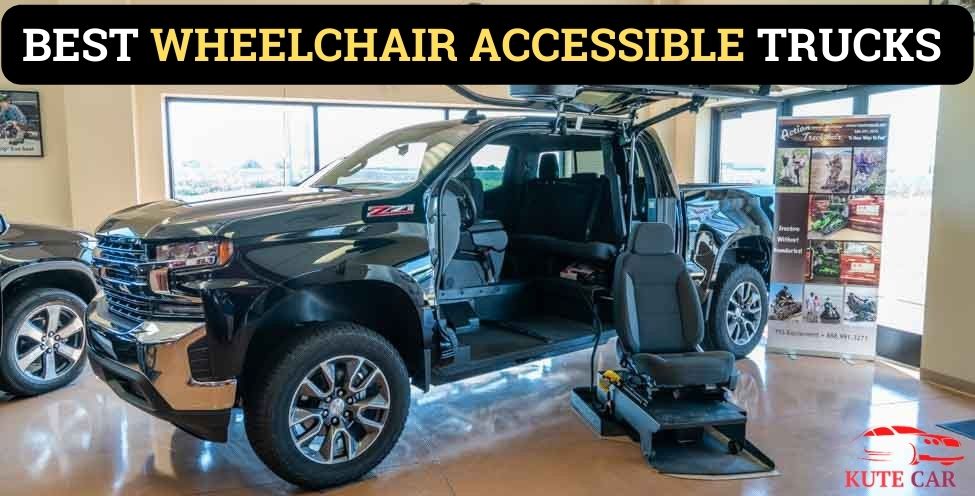In today’s world, factors like accessibility are essential. The wheelchair accessible truck has developed the horizons of those with mobility problems, autonomy, and possibilities to explore the world. This article will explore the innovative concept of wheelchair comfort accessible cars. These vehicles include qualities, uses, and concerns. It enhances the lives of individuals with disabilities.
Best Wheelchair Accessible Trucks in The Market:
Here are 5 wheelchair accessible vans with specs:
1) Dodge Grand Caravan
- Starting MSRP: $34,690
- Engine: 3.6L V6
- Horsepower: 283 hp
- Torque: 260 lb-ft
- Fuel economy: 17 City/25 Highway
- Seating capacity: Up to 7
- Available features: Rear entry ramp, side entry ramp, in-floor ramp, power lift
The Dodge Grand Caravan is a popular minivan that is available in wheelchair-accessible (WAV) configurations. Wheelchair-accessible vehicles are customized automobiles that can easily transport one or more wheelchair users along with the driver or passengers.

Converting a Dodge Grand Caravan into a wheelchair-accessible vehicle typically involves several modifications: Ramp or Lift Installation.
2) Chrysler Pacifica
- Starting MSRP: $36,145
- Engine: 3.6L V6
- Horsepower: 287 hp
- Torque: 262 lb-ft
- Fuel economy: 19 City/29 Highway
- Seating capacity: Up to 8
- Available features: Rear entry ramp, side entry ramp, in-floor ramp, power lift
Both rear-entry and side-entry options are available, each catering to distinct user preferences and requirements. Wheelchair users who have installed this type of ramp can access the vehicle through the rear doors. Those who need to stay seated in their wheelchair throughout the trip choose rear-entry ramps, which allow them to turn around and face the back of the car.

Both rear-entry and side-entry options are available, each catering to distinct user preferences and requirements. Wheelchair users who have installed this type of ramp can access the vehicle through the rear doors. Those who need to stay seated in their wheelchair throughout the trip choose rear-entry ramps, which allow them to turn around and face the back of the car.
Here are some of the benefits of choosing a Chrysler Pacifica WAV: The Pacifica is a popular and well-respected minivan.
WAV conversions for the Pacifica are available from a number of different manufacturers. There are a variety of features available for WAV conversions, including in-floor ramps, fold-out ramps, kneeling systems, and accessible seating.
3) Honda Odyssey
- Starting MSRP: $32,920
- Engine: 3.5L V6
- Horsepower: 280 hp
- Torque: 262 lb-ft
- Fuel economy: 19 City/28 Highway
- Seating capacity: Up to 8
- Available features: Rear entry ramp, side entry ramp, in-floor ramp, power lift
Transforming a Honda Odyssey into a wheelchair-accessible vehicle typically involves several modifications: Ramp or Lift Installation: The accessibility of a WAV hinges on the method of entry and exit.
Honda Odyssey WAVs can be equipped with either rear-entry or side-entry ramps or lifts, catering to the user’s preferences and needs.

It includes securing the wheelchair to the vehicle floor, installing wheelchair tie-downs, and potentially rearranging or removing seats to create adequate space for the wheelchair user.
4) Toyota Sienna
- Starting MSRP: $35,295
- Engine: 3.5L V6
- Horsepower: 295 hp
- Torque: 263 lb-ft
- Fuel economy: 19 City/27 Highway
- Seating capacity: Up to 8
- Available features: Rear entry ramp, side entry ramp, in-floor ramp, power lift
Available options for leather upholstery and power-adjustable seats add a touch of luxury to the cabin. Tri-zone automatic climate control allows different areas of the cabin to have individual temperature settings, catering to the comfort preferences of all occupants.

The safety features includes like a Pre-Collision System, Pedestrian Detection, Lane Departure, and Dynamic Radar Control.
5) Chevrolet Savana
- Starting MSRP: $35,995
- Engine: 6.0L V8
- Horsepower: 310 hp
- Torque: 334 lb-ft
- Fuel economy: 14 City/19 Highway
- Seating capacity: Up to 15
- Available features: Rear entry ramp, side entry ramp, in-floor ramp, power lift
At the core of the Chevrolet Savana’s prowess lies its impressive 6.0L V8 engine. The marriage of the Chevrolet Savana’s chassis and the 6.0L V8 engine results in exceptional performance capabilities.

The interior of the Chevrolet Savana with the 6.0L V8 engine offer both driver and passengers a comfortable and connected experience
The Evolution of Accessibility in Vehicles
There has been a significant shift from basic adaptations to elaborate designs in the manner that automobiles are made accessible for people with impairments.
Understanding Wheelchair Accessible Trucks
Wheelchair-accessible vehicles are customized automobiles that can easily transport one or more wheelchair users along with the driver or passengers If you are in UAE and need more customization for your vehicle, feel free to contact PitStopArbia’s car service and repair team.
Different Types of Ramps
Rear-entry ramps and side-entry ramps are the two most common types of ramps. Another way to categorize ramps is by how they are operated, with automatic ramps being one type and manual ramps being another.
Rear-Access Ramp:
The purpose of a rear-entry ramp is to provide access to the rear of a vehicle, most commonly a van. Wheelchair users who have installed this type of ramp can access the vehicle through the rear doors. Those who need to stay seated in their wheelchair throughout the trip generally choose rear-entry ramps, which allow them to turn around and face the back of the car.
Side-Entry Ramps:
As the name states, a side-entry ramp is mounted alongside a vehicle’s side door. Wheelchair users can enter the car through the side sliding door with the help of this ramp.
Automatic Ramps:
A button on a control panel is all that’s needed to activate an automatic ramp. Wheelchair users and their caretakers can benefit from the automatic extending and retracting capabilities of these ramps. Automatic ramps are helpful for those who have difficulty manually raising or folding a ramp, such as those with limited upper body strength or mobility.
Manual Ramps:
To open, close, or fold a manual ramp takes actual physical effort. The user or a caretaker must manually control these ramps. Accessible ramps are frequently less expensive than automatic ramps and can still reliably accommodate those with mobility issues.
Wheelchair-accessible Vehicle Ramp Sizes
The ramps or lifts installed in these vehicles are essential for wheelchair users to enter and exit the vehicle. Wheelchair-accessible vehicles’ ramp lengths are customizable to meet the demands of each individual passenger. Some broad rules of thumb are as follows:
Ramp Width:
The width of the ramp is important to make sure that wheelchairs of different widths can use it. Manual wheelchairs are normally 26 inches (66 cm) wide. Wheelchairs with motors or those designed for sports may be broader. In order to accept a wide range of wheelchair widths, a ramp’s width should be at least 30 inches (76 cm).
Ramp Length:
Depending on the required incline for a wheelchair user’s safe and gentle ascent or descent, the ramp’s length will vary. Because of safety concerns, a ramp should be as lengthy as possible. A wheelchair ramp should have a slope of about 1:8, which translates to 8 inches of ramp length for every inch of ramp height. If the vehicle’s floor is 24 inches off the ground, the ramp length should be about 16 feet in order to produce a 1:8 slope.
Weight Capacity:
Wheelchair-accessible car ramps must have sufficient weight capacity to accommodate both the person and the wheelchair. Make sure the person’s weight plus the weight of the wheelchair adds up to more than the ramp’s weight capacity.
Foldability and Storage:
As a space-saving measure, many ramps installed in WAVs are foldable or retractable when not in use. This is especially crucial in compact cars under budget where the room is at a premium.
Accessibility Standards:
The size of the ramp for a wheelchair-accessible vehicle must be determined with care, taking into account local accessibility norms and regulations. Depending on where you live, you may be required to adhere to regulations that specify ramp sizes.
User Requirements:
Wheelchair users may have varying requirements and preferences when it comes to ramp length. Users of the vehicle should be consulted to ensure their requirements are met.
Benefits of Wheelchair Accessible Truck
- Because it helps them to get around without the help of others, a truck is crucial to the autonomy of people with mobility impairments.
- Trucks are renowned for their adaptability. Having the ability to carry not just oneself but also one’s equipment, goods, and even companions is a major benefit.
- Wheelchair users will appreciate the extra room to move around inside a truck compared to more conventional wheelchair-accessible cars.
- Many pickups are built to travel on unpaved roads and other types of rough terrain.
- Wheelchair-accessible vehicles with towing capacity are available. Those who need to bring along extra gear or recreational vehicles would appreciate this.
- Wheelchair-accessible pickups can be modified to meet the individual demands of their owners. Adjustments to seating, ramps, lifts, and other infrastructure may also be made.
- Aesthetically, a truck offers a beautiful and sturdy alternative to conventional accessible vans for those who enjoy the appearance and feel of a truck.
- Trucks typically retain a high resale value in the secondhand auto market.
- Safety is due to a greater vantage point on the road, as the driver sits higher in most trucks.
- Long-distance travel is possible in this vehicle with the correct adaptations.
- People who use wheelchairs yet need a vehicle for work might benefit greatly from the availability of these vehicles.
- Like any vehicle, a wheelchair-accessible pickup can be a means of expressing the driver’s unique sense of style and character.
Conclusion
Both individuals and groups can help everyone get around better by understanding the different types of ramps and how they can be used. These ramps are made to help people with difficulties moving around to go in and out of buildings and other places more easily.
FAQs Regarding The Wheelchair Accessible Truck
Q.1) How is the wheelchair lift or ramp operated?
The wheelchair lift or ramp works through hydraulic, electric, or pneumatic systems. Controls can be located within the truck’s interior or integrated into a remote device for ease of use.
Q.2) What are lowered floors in a wheelchair-accessible truck?
Lowered floors involve modifying the interior floor height of the truck to create sufficient headroom for a wheelchair user.
Q.3) How are wheelchairs secured inside the truck?
Wheelchairs are secured using specialized wheelchair tie-down and restraint systems.
Q.4) Are there developments in autonomous driving technology for wheelchair-accessible trucks?
While fully autonomous driving for wheelchair-accessible trucks is still in development, to integrate self-driving technology with adaptive controls to enhance mobility for individuals with disabilities.
Q.5) Can I control and monitor my wheelchair-accessible truck using a mobile app?
Some modern wheelchair-accessible trucks come with companion mobile apps that allow users to remotely control features, monitor vehicle status, and receive notifications, making the overall experience more convenient.



